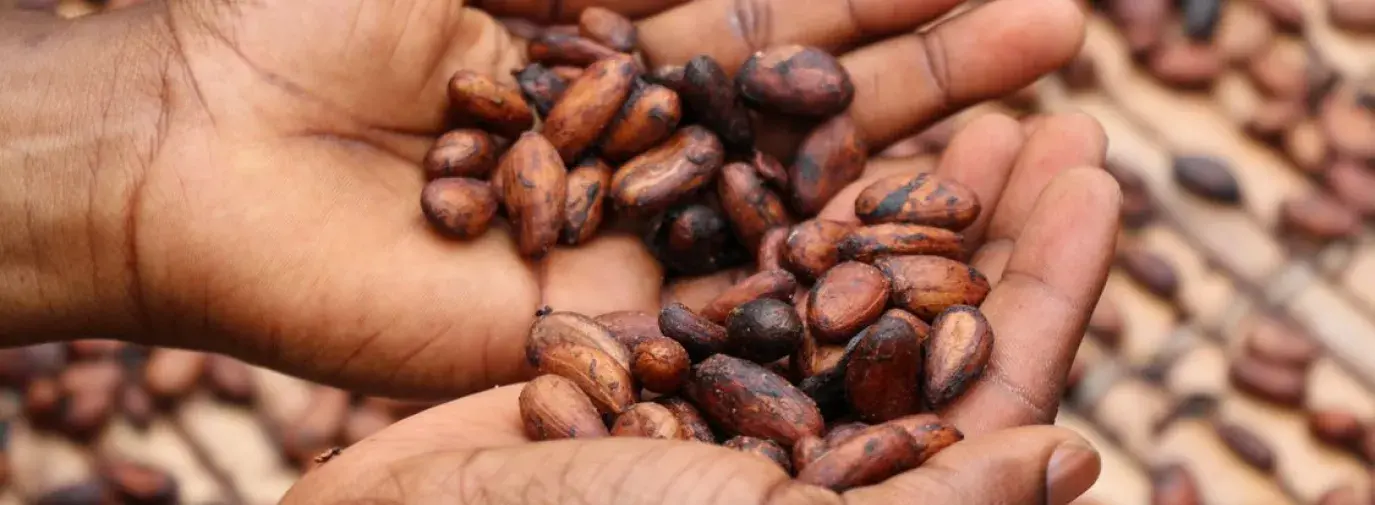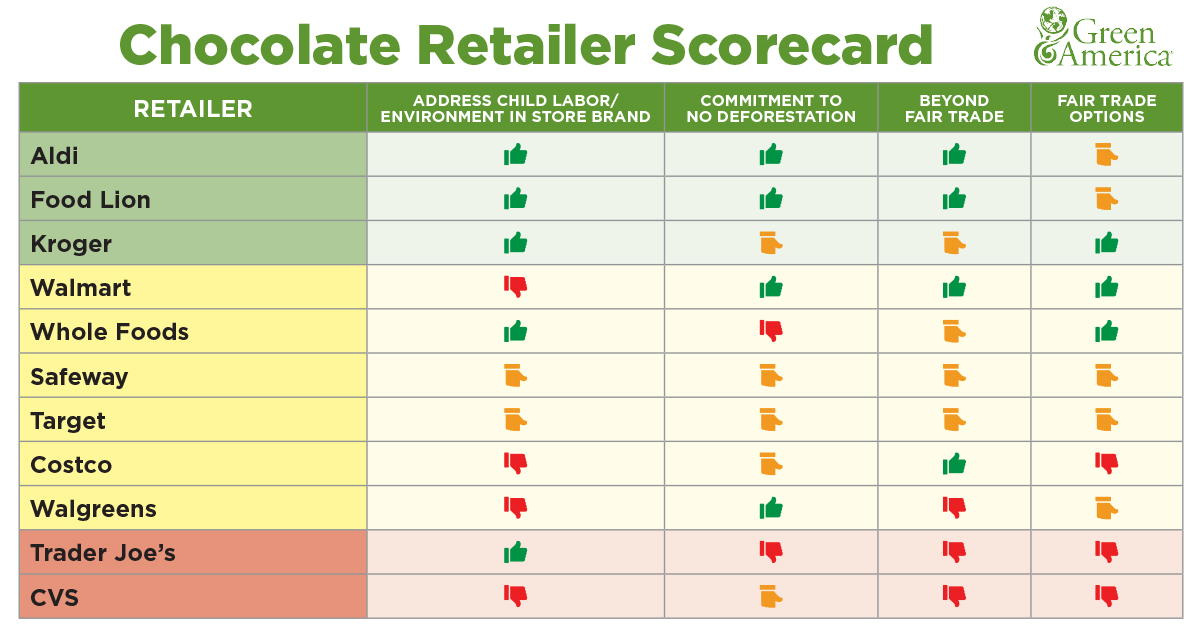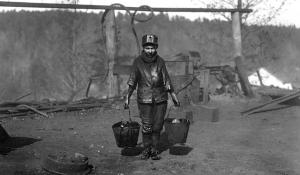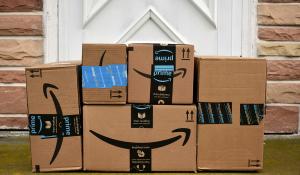
Child labor in the chocolate industry has been a well-known problem for decades, and despite numerous stakeholders pressuring big chocolate companies to address the issue, child labor remains prevalent in West Africa’s cocoa industry. In addition to our annual Chocolate Scorecard rating major US chocolate companies, this scorecard rates stores carrying chocolates.

Why a retailer scorecard?
Green America issues an annual Chocolate Scorecard, which rates major US chocolate companies on its efforts to address child labor. Building on that scorecard, we think it is important to highlight the role that grocery stores and pharmacies have in perpetuating child labor issues in cocoa. Store brand or ‘own brand’ chocolate is gaining a bigger and bigger market share, but grocery stores or retailers have not received the same kind of consumer and civil society pressure that chocolate companies, like Godiva, have received.
Retailers make billions of dollars on chocolate sales, taking up to 44% of the profits while cocoa farmers earn a measly 6.6%, according to the Cocoa Barometer.
This unfair division of chocolate profits must change. Farmers need to be paid more, or we have no hope of ending child labor in the cocoa industry.
One of the results of consumer, civil society, and government pressure on the chocolate industry is big chocolate brands developing sustainability initiatives. This pressure has also led to greater transparency about what chocolate brands are doing to address social and environmental harms, including child labor and deforestation.
But, it is retailers that control what chocolates the public sees, and likely buys. And, since these retailers make the bulk of the profit off of chocolate, they should take the lead in promoting products that benefit farmers and the environment.
Grocery stores and chocolate companies’ commitments to fair trade chocolate vary widely. Many chocolate companies have made time-bound commitments to fair trade chocolate, but as you can see in the scorecard, far fewer grocery stores have a fair trade option of chocolate for their store brand, let alone commitment to 100% fair trade chocolate – and this must change!
What can you do?
- If your favorite retailer received a low score, you can reach out to its customer service team to let them know this is an issue you care about and that you hope they will make advances in addressing child labor and deforestation in chocolate production in 2020.
- If your favorite retailer did well, you can also let them know! It is important that companies know what their consumers care about and keep prioritizing the issue.
- If you have the option, you can also use your purchasing power to shop with local stores with a wide variety of fair trade chocolate options or shop from some of the higher scoring retailers, like Aldi.
- You can also buy your Valentine's Day chocolates directly from these A-rated chocolate companies!
How we determined the ratings:
We chose some of the largest US retailers to look at its efforts to address child labor in cocoa; we also included Trader Joe’s, as after the release of the 2019 Chocolate Scorecard, we had numerous members reach out with questions about Trader Joe’s chocolate. Food Lion is owned by Ahold Delhaize, and we used Ahold’s reporting information for this scorecard; similarly, Safeway is owned by Albertsons, so we used Albertsons' reporting information for this scorecard. Only publicly available information was used for the scorecard (sustainability information from company websites and products listed on company websites or found in stores).
For grading, a mix of colors and thumbs up, down, or sideways was used. For the overall company ratings, green is the highest rating, while there is likely room for improvement, the retailers in green came out on top; yellow indicates that the retailer should be doing more; and red indicates that much more needs to be done in addressing child labor and deforestation in chocolate production.
For each category, thumbs up is the highest rating; a sideways thumb indicates that the retailer should be doing more; and thumbs down indicates that the retailer is either doing nothing or very little.
Companies receiving one or more thumbs down ratings in any category were not eligible for an overall green rating. The categories all carried the same weight. For this scorecard, only chocolate candy and chocolate baking products were considered.
Categories:
- Addressing child labor in the store's brand(s) of chocolate:
 = Offers at least one fair trade option.
= Offers at least one fair trade option.
 = Offers at least one organic option.
= Offers at least one organic option.
 = No fair trade or organic option.
= No fair trade or organic option.
- Has a commitment to no deforestation:
 = There is a commitment to zero deforestation.
= There is a commitment to zero deforestation.
 = There is a deforestation policy, but the company does not commit to zero deforestation.
= There is a deforestation policy, but the company does not commit to zero deforestation.
 = There was no public deforestation policy.
= There was no public deforestation policy.
- Beyond fair trade:
 = The retailer notes that child labor or poverty are an issue in the cocoa industry, and it is doing something to address it.
= The retailer notes that child labor or poverty are an issue in the cocoa industry, and it is doing something to address it.
 = The retailer mentions the connection between cocoa and child labor or poverty but is not clearly doing something to specifically address it, or if a company had a strong no child labor policy across multiple commodities.
= The retailer mentions the connection between cocoa and child labor or poverty but is not clearly doing something to specifically address it, or if a company had a strong no child labor policy across multiple commodities.
 = There was no mention of child labor and cocoa, and/or a weak child labor policy.
= There was no mention of child labor and cocoa, and/or a weak child labor policy.
- Note, nearly every retailer did have a no child labor policy, though we believe it is important that all companies publicly recognize those goods that are at a higher risk for child labor.
- Note, nearly every retailer did have a no child labor policy, though we believe it is important that all companies publicly recognize those goods that are at a higher risk for child labor.
- Fair trade options:
 = The retailer offers 11 or more fair trade certified chocolate brands.
= The retailer offers 11 or more fair trade certified chocolate brands.
 = The retailer offers between 6-10 different brands.
= The retailer offers between 6-10 different brands.
 = The retailer offered 5 or less fair trade options of chocolate brands.
= The retailer offered 5 or less fair trade options of chocolate brands.
- This category consisted of estimates, and retailers' inventory can vary by location and may differ online versus in-store. We looked at information available online in most cases. In the case of Trader Joe’s, we visited a few store locations in the DC area. As Albertsons owns multiple grocery store chains, we looked at Safeway for this category; Ahold Delhaize also owns multiple grocery store chains, and we looked at Food Lion for this category. In the case of Aldi, since it sells very few other brands of chocolate and as its own brand is fair trade certified, we made an exception for this category, and Aldi received a sideways thumb.
- If a retailer's own brand is fair trade, it was not counted in this category as they already received credit for this in the first category. Only chocolate candy was included for this category.






